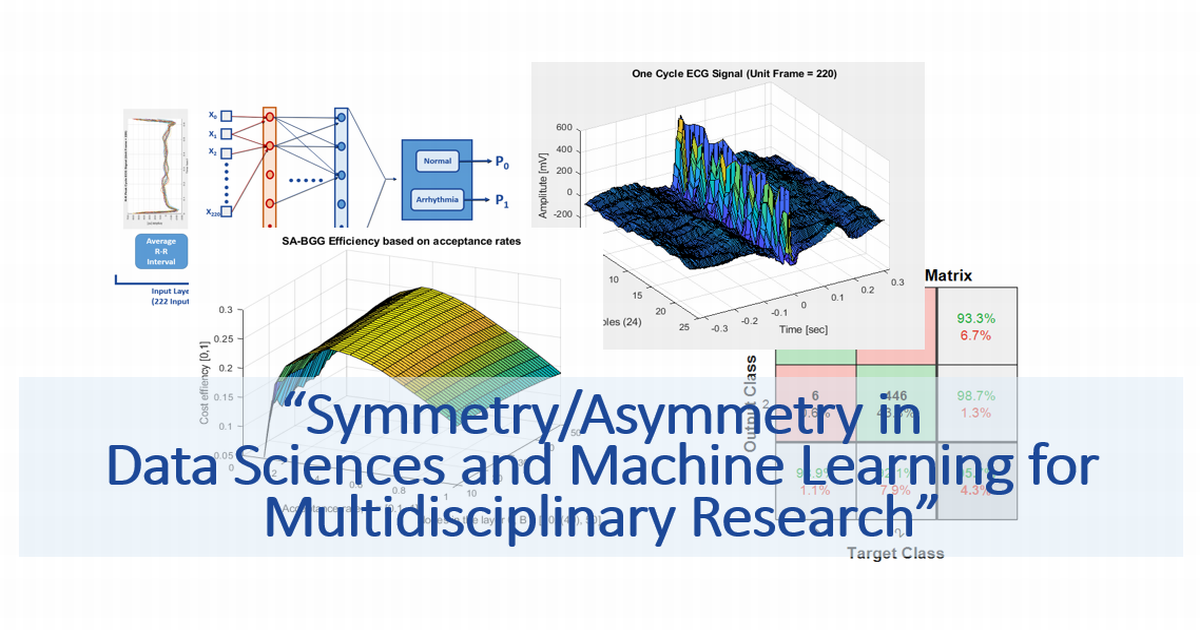Symmetry/Asymmetry in Data Sciences and Machine Learning for Multidisciplinary Research
A special issue of Symmetry (ISSN 2073-8994). This special issue belongs to the section "Computer".
Deadline for manuscript submissions: closed (30 June 2022) | Viewed by 10226

Special Issue Editors
Interests: probability theory; data sciences; machine learning; game theory; blockchain governance game; biometircs; applied statisitcs
Special Issues, Collections and Topics in MDPI journals
Special Issue Information
Dear Colleagues,
We would like to invite you to submit your work to the Special Issue “Advances in Data Sciences and Machine Learning for Multidisciplinary Research” which is aligned with symmetry/asymmetry phenomena. This Special Issue is seeking high-quality contributions in both theoretical and applied data sciences/statistics techniques to solve practical applications.
This Special Issue of Symmetry features articles about solving real-world problems by designing new data centric techniques, including data sciences, statistical analysis, and machine learning with reflection of symmetry/asymmetry phenomena. We are soliciting contributions to cover practically any range of topics, including engineering, economics, marketing, biometrics, human behavior, business analytics, telecommunications, cybersecurity, the Internet of Things, and mechatronics. The main criterion for submissions is developing innovative data centric methods to tackle real-world problems. There is no page limit, but contributions must demonstrate knowledge of the theatrical background and the practicality of the topic of the submission.
Submit your paper and select the Journal “Symmetry” and the Special Issue “Symmetry/Asymmetry in Data Sciences and Machine Learning for Multidisciplinary Research” via: MDPI submission system. Our papers will be published on a rolling basis and we will be pleased to receive your submission once you have finished it.
Dr. Song-Kyoo (Amang) Kim
Dr. Chan Yeob Yeun
Guest Editors
Manuscript Submission Information
Manuscripts should be submitted online at www.mdpi.com by registering and logging in to this website. Once you are registered, click here to go to the submission form. Manuscripts can be submitted until the deadline. All submissions that pass pre-check are peer-reviewed. Accepted papers will be published continuously in the journal (as soon as accepted) and will be listed together on the special issue website. Research articles, review articles as well as short communications are invited. For planned papers, a title and short abstract (about 100 words) can be sent to the Editorial Office for announcement on this website.
Submitted manuscripts should not have been published previously, nor be under consideration for publication elsewhere (except conference proceedings papers). All manuscripts are thoroughly refereed through a single-blind peer-review process. A guide for authors and other relevant information for submission of manuscripts is available on the Instructions for Authors page. Symmetry is an international peer-reviewed open access monthly journal published by MDPI.
Please visit the Instructions for Authors page before submitting a manuscript. The Article Processing Charge (APC) for publication in this open access journal is 2400 CHF (Swiss Francs). Submitted papers should be well formatted and use good English. Authors may use MDPI's English editing service prior to publication or during author revisions.
Keywords
- data sciences
- applied statistics
- business analytics
- artificial intelligence
- machine learning
- deep learning
- engineering (mechanical, civil, chemical)
- emerging technologies (telecommunication, Blockchain, IoT, cybersecurity)
- medicine (medical engineering, biometrics)
- management (human resources, operations management, finance)
Benefits of Publishing in a Special Issue
- Ease of navigation: Grouping papers by topic helps scholars navigate broad scope journals more efficiently.
- Greater discoverability: Special Issues support the reach and impact of scientific research. Articles in Special Issues are more discoverable and cited more frequently.
- Expansion of research network: Special Issues facilitate connections among authors, fostering scientific collaborations.
- External promotion: Articles in Special Issues are often promoted through the journal's social media, increasing their visibility.
- e-Book format: Special Issues with more than 10 articles can be published as dedicated e-books, ensuring wide and rapid dissemination.
Further information on MDPI's Special Issue policies can be found here.






